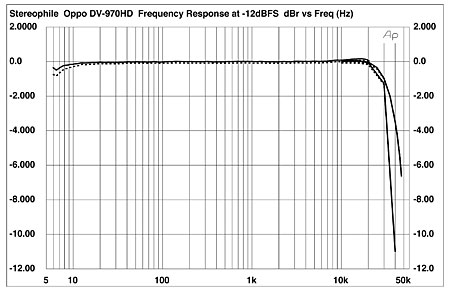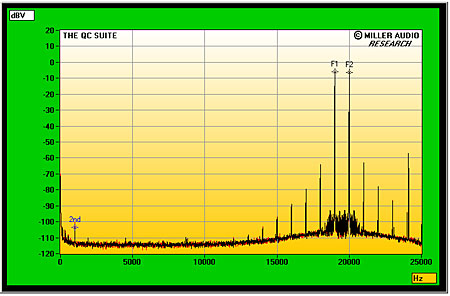| Columns Retired Columns & Blogs |
Oppo DV-970HD universal player Measurements
Sidebar 3: Measurements
I tested the Oppo DV-970HD from its Front L and Front R output jacks, with spot checks on the others. I also had to update the player's firmware—an easy procedure—so that its front-panel display would correctly display SACD tracks numbered higher than 14. (Otherwise, the player's onscreen display, fed to a TV monitor, needed to be used to play SACDs.) The player's maximum output level was 2.2V RMS whether it was playing CDs, DVDs, or SACDs, and the player preserved absolute polarity (ie, was non-inverting) with all three media. The player's error correction was some of the best I've ever encountered: the DV-970HD produced audible glitches in its output and flagged its digital output stream as invalid only when the gaps in the data spiral on the Pierre Verany test CD reached an enormous 3mm in length! Its output impedance was a relatively high 965 ohms in the midrange and treble, easing slightly to 1150 ohms at 20Hz.
The Oppo's frequency response playing back CDs featured a rise at the very top of the audioband (fig.1, top pair of traces at 20kHz), but this is too high in frequency and too small in degree to be audible. The player's response did extend higher with both DVD-Audio and SACD, but unusually, the latter rolled off earlier than the former, reaching –6dB at 33kHz (fig.1, bottom traces above 20kHz), compared with –6dB at 45kHz for 96kHz-sampled DVD data (fig.1, top traces above 20kHz). The CD playback response with a pre-emphasized CD was identical to that with a normal CD and is not shown. L–R and R–L channel separation were both excellent (fig.2), at >100dB below 1kHz, though the crosstalk rose in both directions above that frequency, due to the usual capacitive coupling.

Fig.1 Oppo DV-970HD, frequency response at –12dBFS into 100k ohms (from top to bottom at 30kHz): 96kHz-sampled DVD data, SACD data. Top traces at 20kHz: CD data (right channel dashed, 0.5dB/vertical div.).

Fig.2 Oppo DV-970HD, channel separation (10dB/vertical div.)
The Oppo player produced some paradoxical results when I examined its resolution. The rather complicated-looking graph in fig.3 shows four separate spectral analyses, performed by sweeping a 1/3-octave–wide bandpass filter down from a center frequency of 20kHz to one of 20Hz. The test signal for three of the sweeps was a dithered 1kHz tone at –90dBFS, sourced from a CD, a DVD-A, and an SACD. The tone peaks at the –90dBFS level in all three cases, but the change to the higher-resolution media drops the high-frequency noise floor by around 3dB rather than the 12–18dB I have found with top-performing players and DACs. This is still sufficient for the Oppo to resolve a 1kHz tone at –110dBFS, played back from SACD (fig.3, bottom pair of traces at 1kHz), but at lower frequencies, the noise floor is no better than it is for CD. There is a 60Hz power-supply hum component evident, though this does lie 105dB down from full level, which is acceptably low. But peaks can also be seen at 20Hz and 350Hz, which might be due to spurious idle tones of some kind.

Fig.3 Oppo DV-970HD, 1/3-octave spectrum with noise and spuriae of dithered 1kHz tone at –90dBFS (from top to bottom at 2kHz): 16-bit CD data, 24-bit DVD data, SACD data; dithered 1kHz tone at –110dBFS, SACD data (right channel dashed).
Linearity error, measured using a 500Hz tone on a test CD, was low to below –100dBFS (fig.4), but analog noise obscured the waveform of an undithered 16-bit tone at exactly –90.31dBFS (fig.5), which should reproduce with just three DC voltage levels. The downward slope of the wave in this graph also reveals the presence of low-frequency noise. Correlating with the spectral plots shown in fig.3, increasing the bit depth to 24 produced a waveform (fig.6) that looked very similar to the spectral plots shown in fig.3. The Oppo player really doesn't offer much more resolution from SACD and DVD-A than it does from CD.

Fig.4 Oppo DV-970HD, right-channel departure from linearity, 16-bit data (2dB/vertical div.).

Fig.5 Oppo DV-970HD, waveform of undithered 1kHz sinewave at –90.31dBFS, 16-bit data.

Fig.6 Oppo DV-970HD, waveform of undithered 1kHz sinewave at –90.31dBFS, 24-bit data.
The DV-970HD did produce very low levels of harmonic distortion, even into quite low impedances. Fig.7, for example, was taken with the player driving a full-scale 1kHz tone into 8k ohms, yet all the spurious harmonics lie at –100dB or below. Note, however, that the fifth harmonic (circled) is the highest in level, and the seventh also makes an appearance. The third harmonic lay at –104dB, but at low frequencies, this rose in level to –90dB.

Fig.7 Oppo DV-970HD, spectrum of 1kHz sinewave at 0dBFS into 8k ohms (linear frequency scale).
The picture looked less healthy with intermodulation distortion. With the DV-970HD driving a full-scale mix of 19 and 20kHz tones into 8k ohms (fig.8), the second-order component at 1kHz lay at a respectable –100dB (0.001%). The higher-order components were considerably higher in level, however, and probably of more subjective consequence, the noise floor can be seen to rise around the spectral lines representing the signal components.

Fig.8 Oppo DV-970HD, HF intermodulation spectrum, 19+20kHz at 0dBFS peak into 8k ohms (linear frequency scale).
This kind of behavior is generally associated with poor jitter rejection, and the Oppo fell short of what I would like to have seen in this area, even considering the player's very affordable price. Fig.9 is a narrowband spectral analysis of the DV-970HD's analog output while it played back a CD containing a high-level tone at exactly one-quarter the sample rate, over which had been laid the LSB toggling on and off at 1/192 the same rate. Not only does the same sort of noise-floor modulation seen in fig.8 make an appearance, but a very large number of sidebands can be seen surrounding the peak that represents the HF tone. Those indicated with red numeric markers are related to audio data, those marked in brown to the power supply (those marked in purple are of unknown origin). The jitter level was 4 nanoseconds peak–peak, around 20 times higher than the best playback systems I have measured.

Fig.9 Oppo DV-970HD, high-resolution jitter spectrum of analog output signal (11.025kHz at –6dBFS, sampled at 44.1kHz with LSB toggled at 229Hz), 16-bit CD data. Center frequency of trace, 11.025kHz; frequency range, ±3.5kHz.
Concerned that I was being misled by my test gear, I repeated the test with the same 16-bit signal on a DVD-A, then with a 24-bit version of the data. Both jitter level and spectra were the same. I then repeated the test using a different analyzer, but again with no change in the result. Performing a wideband spectral analysis of the Oppo's output while it played back a high-level tone at 11.025kHz from SACD gave the graph shown in fig.10. Not only are the jitter and noise-floor modulation still apparent, but the idle-tone spectral content at low frequencies seen in earlier graphs is still present. You can also see the rise in ultrasonic noise due to SACD's DSD encoding, but this is low in level, correlating with the somewhat curtailed response above the audioband seen with SACD playback in fig.1.

Fig.10 Oppo DV-970HD, spectrum of analog output signal, 11.025kHz at –3dBFS, SACD data (logarithmic frequency scale).
It is hard to predict the subjective effect of such high jitter, but a flat, rather uninvolving presentation would be my suggestion. I do note that Wes Phillips found that the Oppo player sounded somewhat soft and overripe in the midbass, which is one consequence of high amounts of random jitter, in my experience. He concluded that the DV-970HD's "performance as a standalone player wasn't where I felt its true potential lies, but when connected to a good DAC it punched way outside its class." I must admit that I had trouble checking the quality of the Oppo's digital output because, for a while, I couldn't get it to output audio data with a sample rate greater than 48kHz, even with DVDs that allow an in-the-clear hi-rez signal to be output. The trick, it transpired, was to turn off the HDMI output, which allowed the maximum sample rate of the S/PDIF jacks to be set to 96kHz or 192kHz. Even so, using RME's DIGICheck program, I found that the DV-970's digital output truncated the word length to 16 bits, even with true 24-bit audio (such as my own DVD-As, burned with Minnetonka Software's DiscWelder Bronze program).
Does this matter? Perhaps not, as Wes enthused over the Oppo used as a transport to feed 96kHz-sampled audio to the Slim Devices DAC. But I still would like to have seen all 24 bits active in the digital output words.—John Atkinson
- Log in or register to post comments




































